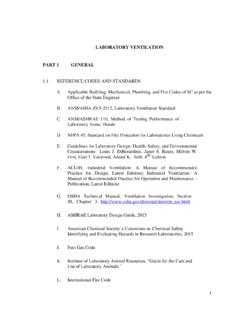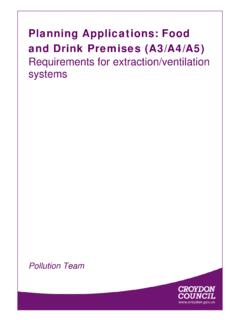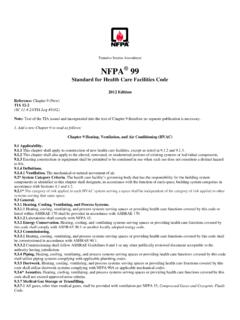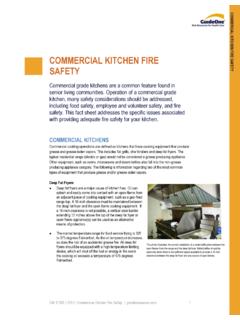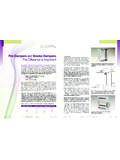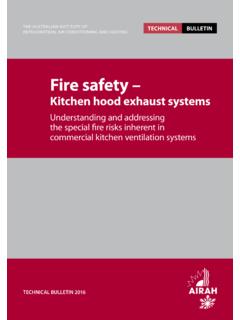Transcription of An ADCAS Guide to Ductwork Cleaning Requirements and ...
1 An ADCAS Guide to Ductwork Cleaning Requirements and Access Doors How to interpret DW/144, TR/19 and BS EN 15780. Ductwork Cleaning Requirements and Access Doors 2. Contents 1. Introduction 3. 2. DW/144 Second Edition 2013 4. 3. TR19 Second Edition 2013 5. 4. BS EN 15780:2011 6. 5. Location of access doors 6. 6. Size of access doors 8. 7. How clean does the Ductwork need to be? 9 8. How should I protect, deliver and install the Ductwork ? 11. 9. FAQs (frequently asked questions) 13. 10. Conclusion 16. 11. Pre-Contract Checklist 17. This document has been produced in good faith by ADCAS to help inform and Guide members. It should not be taken as a definitive summary of all the Requirements of BS EN 15780:2011 or in any way be considered a substitute. Members are strongly advised to fully acquaint themselves with the Requirements and guidance given in all the documents referenced.
2 Ductwork Cleaning Requirements and Access Doors 3. 1. Introduction Ductwork air systems can be a source of spreading disease and infections. With this greater understanding the requirement for access into the Ductwork systems for maintenance, inspection and Cleaning has increased. The importance of regularly Cleaning Ductwork ventilation systems is well established. This can be Cleaning of Ductwork as part of a building maintenance programme or of new Ductwork sys- tems prior to handover. The cleanliness of Ductwork , both existing and new; location of access doors; and the Cleaning and maintenance of ventilation systems are all closely linked. Two important documents were released in 2014, DW/144 Second Edition (Specification for Sheet Metal Ductwork Low Medium and high pressure/velocity air systems); and TR/19. (Internal Cleanliness of ventilation Systems).
3 Both are from B&ES Publications. These documents are important to anyone involved in the Ductwork industry, and they need to be read in conjunction with the British and European Standard, BS EN 15780 ( ventilation for Buildings Ductwork Cleanliness of ventilation Systems). All three of these documents relate to one or all of the topics: Cleaning access, access doors and duct cleanliness. This ADCAS Guide has been produced to explain the similarities and differences between these documents and to provide practical recommendations for the system designers, Ductwork contractors and Cleaning contractors to help them work with all three publications. Ductwork Cleaning Requirements and Access Doors 4. 2. DW/144. DW/144 Second Edition 2013. Specification for Sheet Metal Ductwork - Low, Medium & High Pressure/Velocity Air Systems (released 22nd May 2014). DW/144 is recognised throughout the UK as the good practice standard specification for the manufacture and installation of Ductwork constructed from sheet metal.
4 It is neither a British nor European Standard. The 2nd Edition takes into consideration advances in manufacture, technology and statute Requirements . There are particular changes to the access door and Cleaning Requirements in this version compared to its predecessor, the 1998. version. The sections of this document that relate to access doors and Cleaning Requirements are: Section 20. ACCESS/INSPECTION OPENINGS. page 90. Appendix G. HANDLING, STORAGE AND PROTECTION OF Ductwork . page 148. Appendix H. GUIDANCE NOTES FOR Cleaning INSPECTION AND Cleaning ACCESS OPENINGS. page 151. DW144 does not specifically relate to fire rated Ductwork systems, however with many overclad fire rated products in common use, the recommendations of DW/144 are generally interpreted as equally applicable to such systems. B&ES. Document DW/172 offers more information on this topic.
5 Ductwork Cleaning Requirements and Access Doors 5. 3. TR/19. Internal cleanliness of ventilation Systems Second Edition 2013 (released 22nd May 2014). TR/19 is a good practice Guide for the internal cleanliness of ventilation systems. The Guide was first published in 2005 as an amalgamation of the TR/17 Guide and publication DW/TM2, which related to the internal cleanliness of new Ductwork systems. This second edition incorporates reference to BS EN 15780. Also in this edition, changes have been made to highlight the current best practices for the maintenance of kitchen extract systems. It should be noted that such systems are often of fire-rated construction. The main sections of this document that relate to access doors and Cleaning Requirements are: Section 2. NEW Ductwork system CLEANLINESS. page 8. Section 3. DESIGN AND ACCESS TO THE INTERNAL SURFACES OF THE ventilation system .
6 Page 11. Section 7. SPECIFIC CONSIDERATIONS FOR KITCHEN EXTRACT SYSTEMS. page 29. Appendix A. ACCEPTABLE DUST ACCUMULATION (NEW Ductwork ). page 44. Ductwork Cleaning Requirements and Access Doors 6. 4. BS EN 15780:2011. ventilation for buildings Ductwork - Cleanliness of ventilation Systems (released in 2011). BS EN 15780:2011 is the British and European Standard that applies to and specifies the assessment criteria for the cleanliness and Cleaning procedures for both new and existing ventilation and air conditioning systems. It does not relate to kitchen systems. The whole document is of relevance, but of particular note is Annex F pages 25 to 27. 5. Location of Access Doors DW/144: Table 20 page 92. TR/19: Table 3 page 13. LOCATION OF ACCESS PANELS FOR INSPECTION/SERVICE AND/OR INTERNAL CLEANLINESS. In-line equipment Location Party responsible for provision of suitable access panel Ductwork Contractor Specialist Cleaning Contractor Control dampers Both sides Up-stream panel Down-stream panel Fire dampers Both sides To suit damper maintenance Opposite side Heating/cooling/re-claim rolls Both sides Panel on both sides.
7 Attenuators (rectangular) Both sides Up-stream panel Down-stream panel Attenuators (circular) Both sides Up-stream panel Down-stream panel Filter sections Both sides Up-stream panel Down-stream panel Air turning vanes Both sides Up-stream panel Down-stream panel Changes of direction One side One panel to suit In-duct fans/devices Both sides Up-stream panel Down-stream panel Inlet/exhaust louvre One side One panel to suit . Intermediate Cleaning panels To suit frequency specified in DW/172. The above table is shown in both TR/19 and DW/144 as tables 3 and 20 respectively. It is important to read the accompanying notes (1-8 in TR/19 and 1-4 in DW/144). Ductwork Cleaning Requirements and Access Doors 7. The table below consolidates the information from both documents and their respected accompanying notes. It also adds further points which ADCAS believe will assist interpretation.
8 ADCAS table amplifying DW144 and TR19 information LOCATION OF ACCESS PANELS FOR INSPECTION/SERVICE AND/OR INTERNAL CLEANLINESS. In-line equipment Location Party responsible for provision of suitable access panel Ductwork Contractor Specialist Cleaning Contractor Circular control dampers 100 Both sides Up-stream panel Down-stream panel Rectangular control dampers 100x100 Both sides Up-stream panel Down-stream panel Fire dampers Both sides To suit damper maintenance Opposite side Heating/cooling/re-claim coils Both sides Panel on both sides . Attenuators (rectangular) Both sides Up-stream panel Down-stream panel Attenuators (circular) Both sides Up-stream panel Down-stream panel Filter sections Both sides Up-stream panel Down-stream panel Air turning vanes Both sides Up-stream panel Down-stream panel Changes of direction One side One panel to suit In-duct fans/devices Both sides Up-stream panel Down-stream panel Inlet/exhaust louvre One side One panel to suit.
9 Intermediate Cleaning panels in fire rated duct To suit frequency specified in DW/172. Intermediate Cleaning panels in standard Every 15m in horizontal Ductwork Ductwork Vertical Ductwork One panel top and bottom At each accessible floor Circular pressed bends Not required . Circular segmented bends Up-stream panel . Of note are the following statements: Section of TR/19 with reference to table 3: In a new Ductwork system these are the only access panels that a Ductwork contractor will provide unless there is a clear indication by the designer /specifier as to their Requirements for access to facilitate Cleaning /survey/inspection or Cleaning activity.. Ductwork Cleaning Requirements and Access Doors 8. Note 6, TR/19, Table 3: A change of direction is deemed to be a 90 degree bend and branches. With regard to circular Ductwork it is not necessary for there to be an access panel on every change of direction.
10 This statement can be interpreted in various ways. ADCAS recommends that there is no requirement to have Cleaning access doors at circular pressed bends, which in any event is not the responsibility of the Ductwork contractor. It would seem logical as there are no obstructive elements to a pressed bend. These bends can be considered part of the Ductwork run and therefore require access panels at every installed by a specialist Cleaning contractor. Note 2, DW/144, Table 20. This note infers that access panels may be required at: segmented bends in spirally wound Ductwork . Again, ADCAS . believes it would be the responsibility of the specialist Cleaning contractor to install these. Of significant note is this statement: Appendix H, DW/144: In the absence of any indication by the system designer for Cleaning Requirements only the access panels for inspection and servicing set out in Section 20 of this specification will be incorporated into a new Ductwork system .
